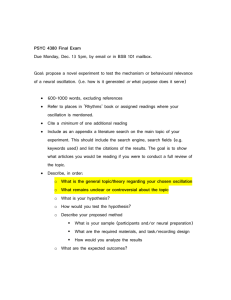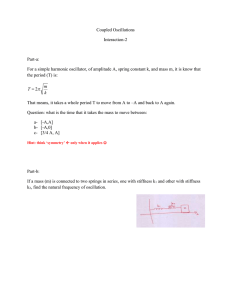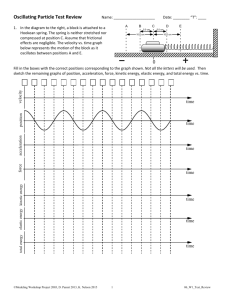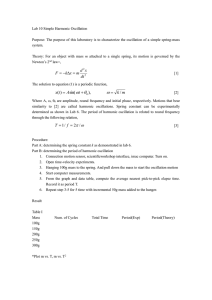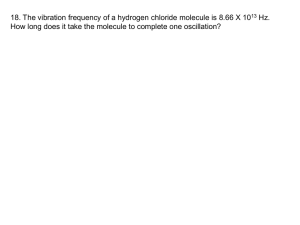Phase of oscillation
advertisement
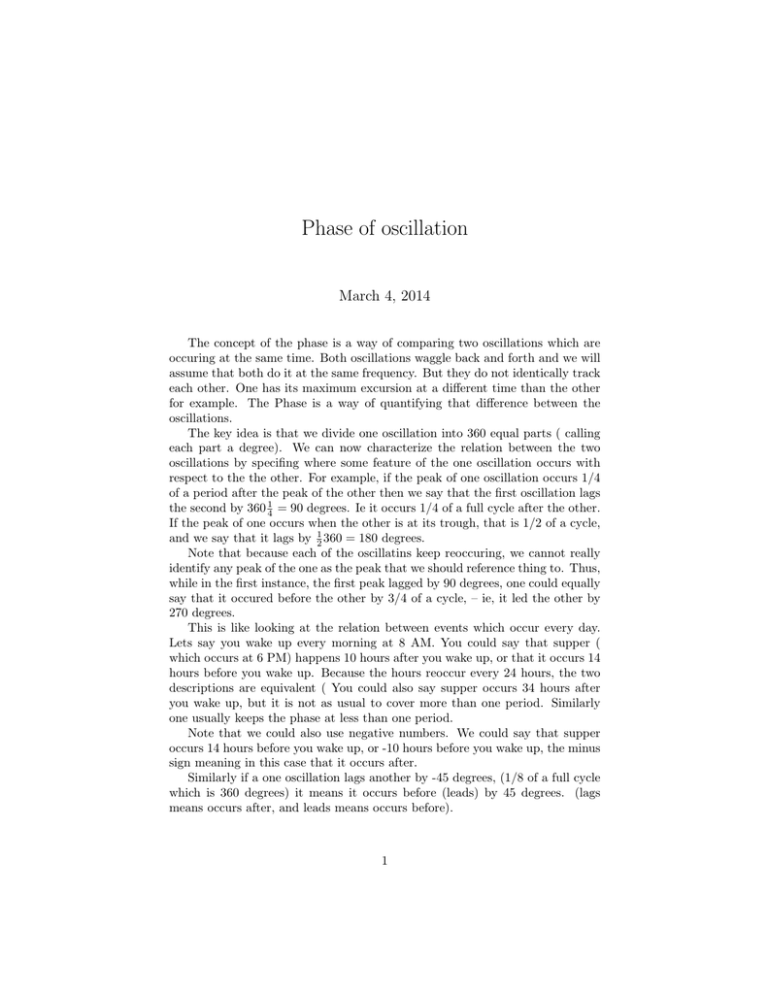
Phase of oscillation March 4, 2014 The concept of the phase is a way of comparing two oscillations which are occuring at the same time. Both oscillations waggle back and forth and we will assume that both do it at the same frequency. But they do not identically track each other. One has its maximum excursion at a different time than the other for example. The Phase is a way of quantifying that difference between the oscillations. The key idea is that we divide one oscillation into 360 equal parts ( calling each part a degree). We can now characterize the relation between the two oscillations by specifing where some feature of the one oscillation occurs with respect to the the other. For example, if the peak of one oscillation occurs 1/4 of a period after the peak of the other then we say that the first oscillation lags the second by 360 14 = 90 degrees. Ie it occurs 1/4 of a full cycle after the other. If the peak of one occurs when the other is at its trough, that is 1/2 of a cycle, and we say that it lags by 21 360 = 180 degrees. Note that because each of the oscillatins keep reoccuring, we cannot really identify any peak of the one as the peak that we should reference thing to. Thus, while in the first instance, the first peak lagged by 90 degrees, one could equally say that it occured before the other by 3/4 of a cycle, – ie, it led the other by 270 degrees. This is like looking at the relation between events which occur every day. Lets say you wake up every morning at 8 AM. You could say that supper ( which occurs at 6 PM) happens 10 hours after you wake up, or that it occurs 14 hours before you wake up. Because the hours reoccur every 24 hours, the two descriptions are equivalent ( You could also say supper occurs 34 hours after you wake up, but it is not as usual to cover more than one period. Similarly one usually keeps the phase at less than one period. Note that we could also use negative numbers. We could say that supper occurs 14 hours before you wake up, or -10 hours before you wake up, the minus sign meaning in this case that it occurs after. Similarly if a one oscillation lags another by -45 degrees, (1/8 of a full cycle which is 360 degrees) it means it occurs before (leads) by 45 degrees. (lags means occurs after, and leads means occurs before). 1 Since both oscillations are going on all the time, it may sound strange to say that one oscillation lags another. They are both happening all the time. What it means is that some feature of the oscillation– the oscillation has its maximum excursion, or the oscillation passes through 0 in the positive direction, or whatever feature of the oscillation you are most interested. To say one oscillatin lags the other by some number of degrees mean that whatever feature of one oscillation you are interested in in one of them occurs after that same feature in the other. 2 1 0.5 0 -0.5 -1 0 2 4 6 0 2 4 6 1 0.5 0 -0.5 -1 3 Figure1– Two waves with the same frequency In figure 1, I have the graph of two oscillations, each of which has a period of just over 6 (for those interested, the period is 2π which is about 6.29). The lower oscillation lags the upper by 2, which is just under 2/6.29 or approximately 1/3 of a cycle. Ie the lower one lags the upper by about 120 degrees. You could also say that the upper was later than the lower by 2/3 of a period of 240 degrees. So, all of these statements are equivalent. The lower lags the upper by 120 degrees. The upper lags the lower by 240 degrees. The lower lags the upper by -240 degrees. The lower leads the upper by 240 degrees. The upper lags the lower by -120 degrees. Thus in resonance, at very low frequencies, the force on the oscillator and the position of the oscillator have the same phase, meaning that the one does not lag the other. At the resonant frequency, the position of the oscillator lags the applied force by 90 degrees. This means that when the force is largest in the positive direction, the position will be its equilibrium point of the oscillation going in the positive direction. When the force has gone to 0 (with it having been positive just before) the displacement of the oscillator is at its maximum. When the force is its maximum in the negative direction the displacement is at 0 heading toward negative displacements etc. At frequencies much higher than the resonant frequency, the phase difference between the force and the displacement goes toward 180 degrees. Ie, the force and the displacement are in exact opposition. The width of the range of frequencies over which the phase difference between the force and the displacement goes from 0 to 180 ( or to be more definite, lets say from 45 degrees to 135 degrees) is proportional to 1/Q. Ie the higher the Q, the smaller the frequency range over which the phase changes. Note that phase is sometime used to designate a certain part of the oscillation. In this case one must always specify a reference point in the cycle. For example one could designate the point in the osciallation when the oscillation is 0 and is going from negative to positive. In that case, the maximum would occur at a phase of 90 degrees, the next, negative going zero at 180 degrees, the most negative point at 270 degrees, and the next positive going zero at 360 degrees. Equally one could say that the maximum was at -270 degrees, the next negative going zero at -180 degrees, and the minumum at -90 degrees. Copyright W G Unruh 4
